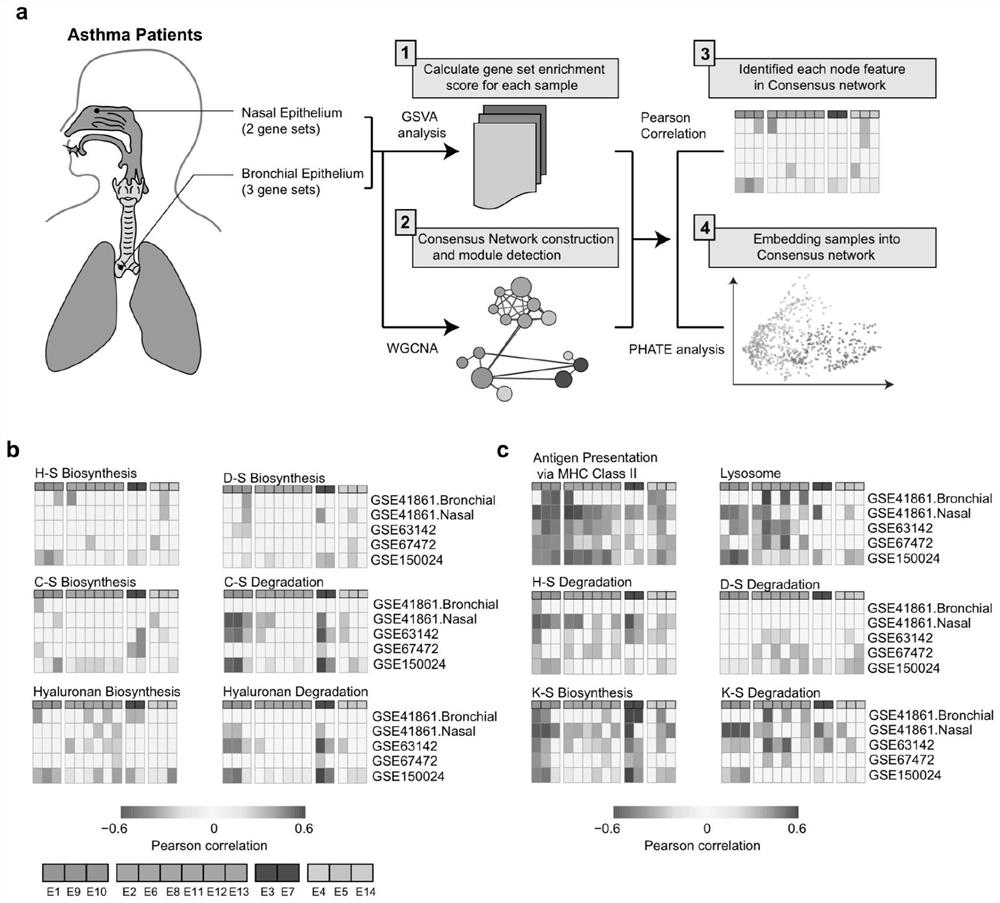Application of SUMF2 gene in preparation of medicine for preventing and/or treating allergic asthma attack and reducing airway hyperresponsiveness
An allergic asthma, genetic technology, applied in the biomedical field, can solve problems such as airflow limitation
- Summary
- Abstract
- Description
- Claims
- Application Information
AI Technical Summary
Problems solved by technology
Method used
Image
Examples
Embodiment 1
[0032] A screening method for the SUMF2 gene in patients with allergic asthma, using bioinformatics analysis to establish an asthma time-series model, the analysis process is as follows figure 1 Shown in a.
[0033] Obfuscation of RNA-seq and microarray data of nasal mucosa and airway epithelium in patients with asthma. First, the GSVA analysis method was used to reduce the dimensionality of the original data, so that the expression profile data changed from the expression value of a single gene to the enrichment degree of different signaling pathways, and a cell pathway enrichment matrix was obtained. Secondly, weighted gene co-expression network analysis (WCGNA) was performed on 5 sets of RNA-seq and microarray data from different samples, using genes as nodes and the Pearson correlation of expression values between genes as weights to generate a gene expression regulation network map. Select the common parts of the 5 sets of gene expression regulatory network diagrams to...
Embodiment 2
[0039] Allergic asthma animal model construction method and index detection
[0040] The 4-week-old C57BL / 6N female mice of SPF grade were fed with normal feed, free to drink water, and grew normally in a well-ventilated environment with a temperature of 20-25°C and a humidity of 40%-60%. The feeding and use of experimental animals adopts the "3R" principle and gives humanitarian care.
[0041] The mice were randomly divided into acute asthma group, acute exacerbated asthma group, chronic asthma group, chronic asthma rest group for 2 weeks, chronic asthma rest group for 3 weeks, chronic asthma relapse group for 4 weeks, acute lung injury group and controls in each group Group. After the experiment, the mice were euthanized, and the success of the model establishment was judged according to the pathological characteristics of the lungs, such as smooth muscle hyperplasia, pulmonary fibrosis, and the number of infiltration of eosinophils, neutrophils, lymphocytes, and monocytes....
Embodiment 3
[0047] Packing, collection, purification and titer determination of adeno-associated virus
[0048] The adeno-associated virus subtypes (AAV5, AAV6, AAV9) that have been reported in the literature and can bind to mouse lung cells were selected for preliminary experiments. The mice were lavaged with AAV5-GFP, AAV6-GFP, and AAV9-GFP viruses provided by Hanheng Company, and euthanized 21 days later, and the expression of GFP in mouse lung cells was detected by immunohistochemical staining . Such as Figure 5 As shown in c, AAV5 mainly binds to alveolar epithelial cells; AAV9 can bind to both airway epithelial cells and alveolar epithelial cells; and AAV6 can well target airway epithelial cells. Therefore, AAV6 was chosen as the vector to deliver the Sumf2 gene.
[0049] In this example, AAV6 subtypes that can well target mouse lung airway epithelial cells were selected to overexpress SUMF2. The AAV6 genome includes two inverted terminal repeats (ITRs) and two open reading fra...
PUM
 Login to View More
Login to View More Abstract
Description
Claims
Application Information
 Login to View More
Login to View More - R&D
- Intellectual Property
- Life Sciences
- Materials
- Tech Scout
- Unparalleled Data Quality
- Higher Quality Content
- 60% Fewer Hallucinations
Browse by: Latest US Patents, China's latest patents, Technical Efficacy Thesaurus, Application Domain, Technology Topic, Popular Technical Reports.
© 2025 PatSnap. All rights reserved.Legal|Privacy policy|Modern Slavery Act Transparency Statement|Sitemap|About US| Contact US: help@patsnap.com



